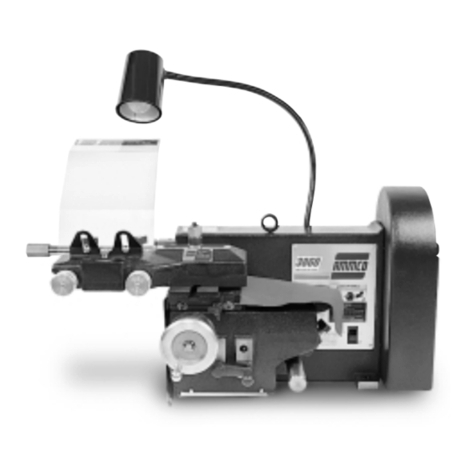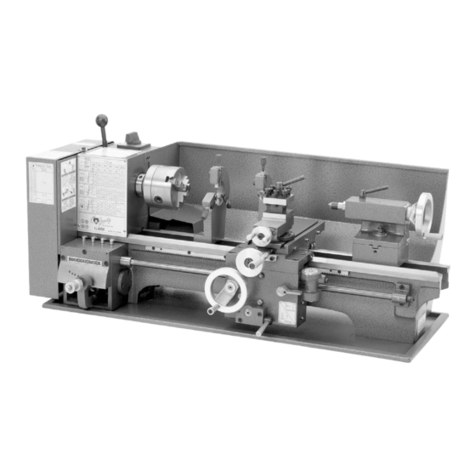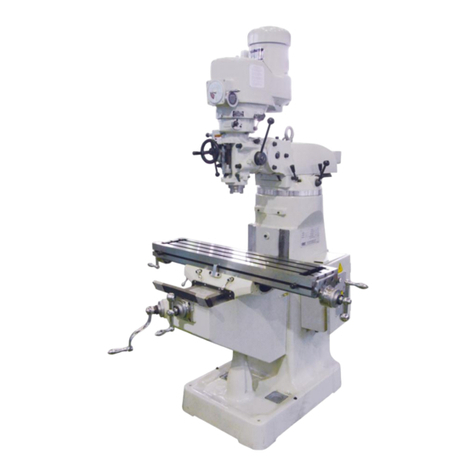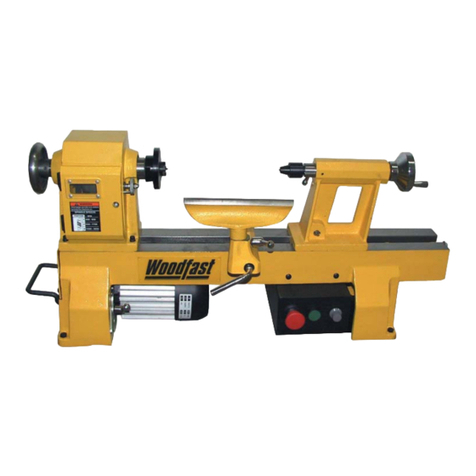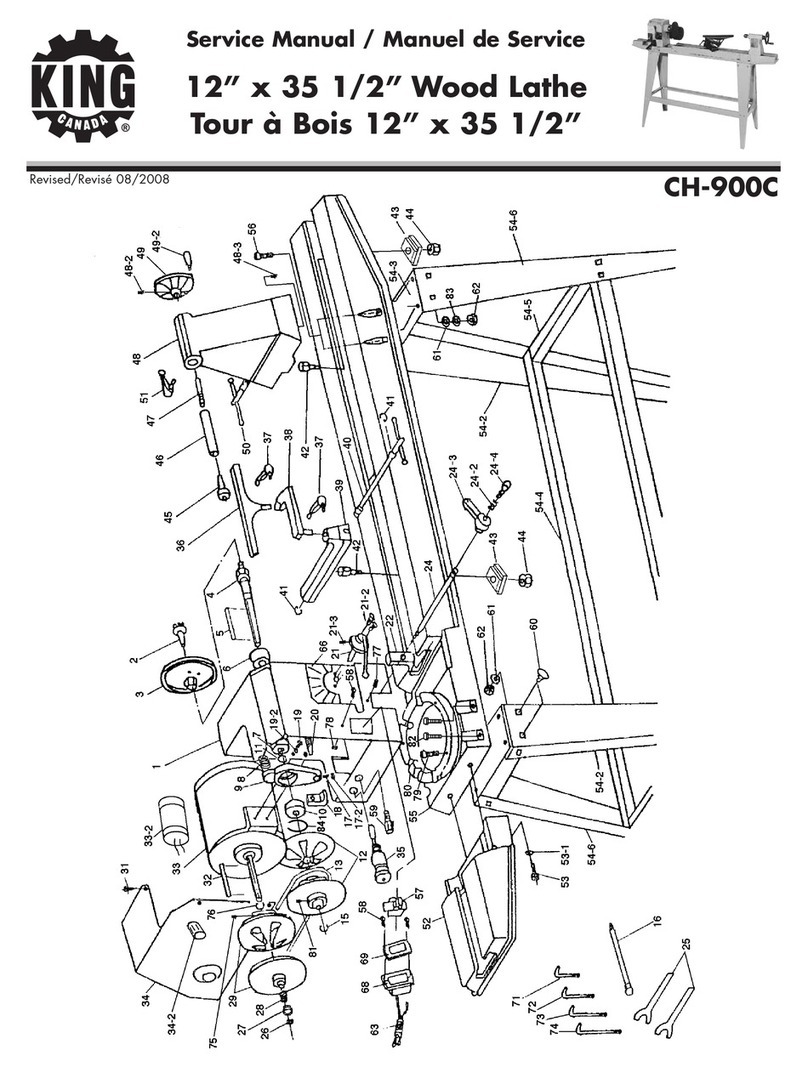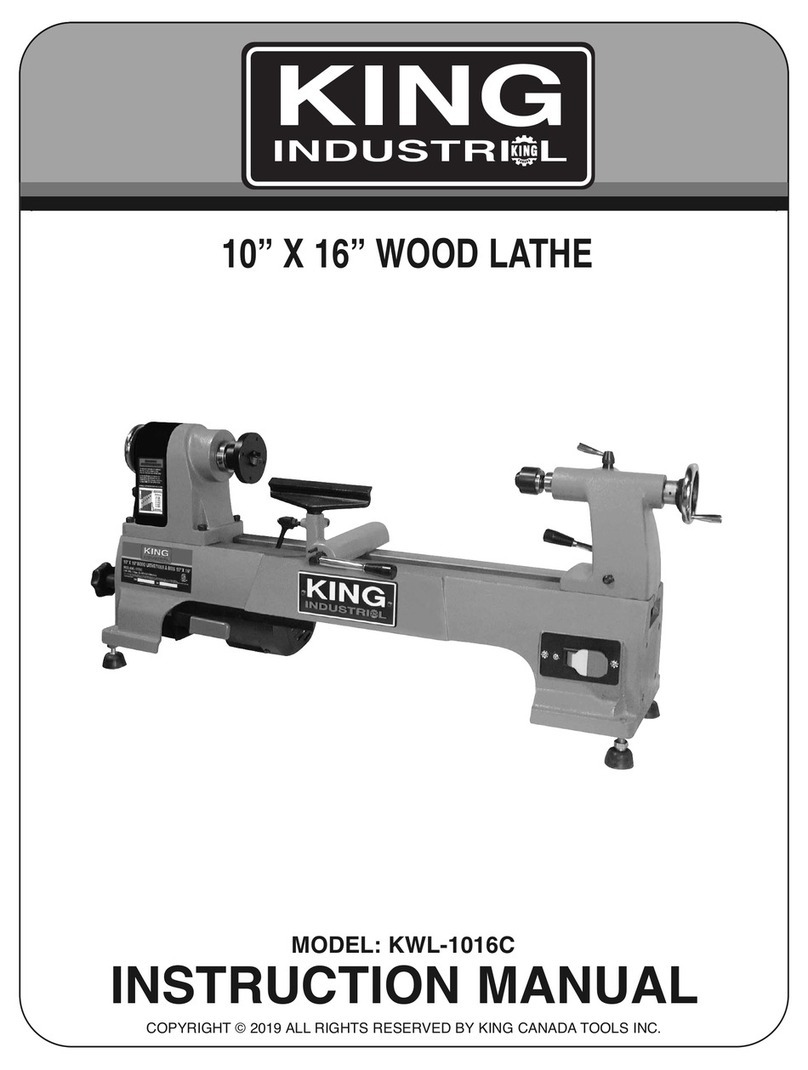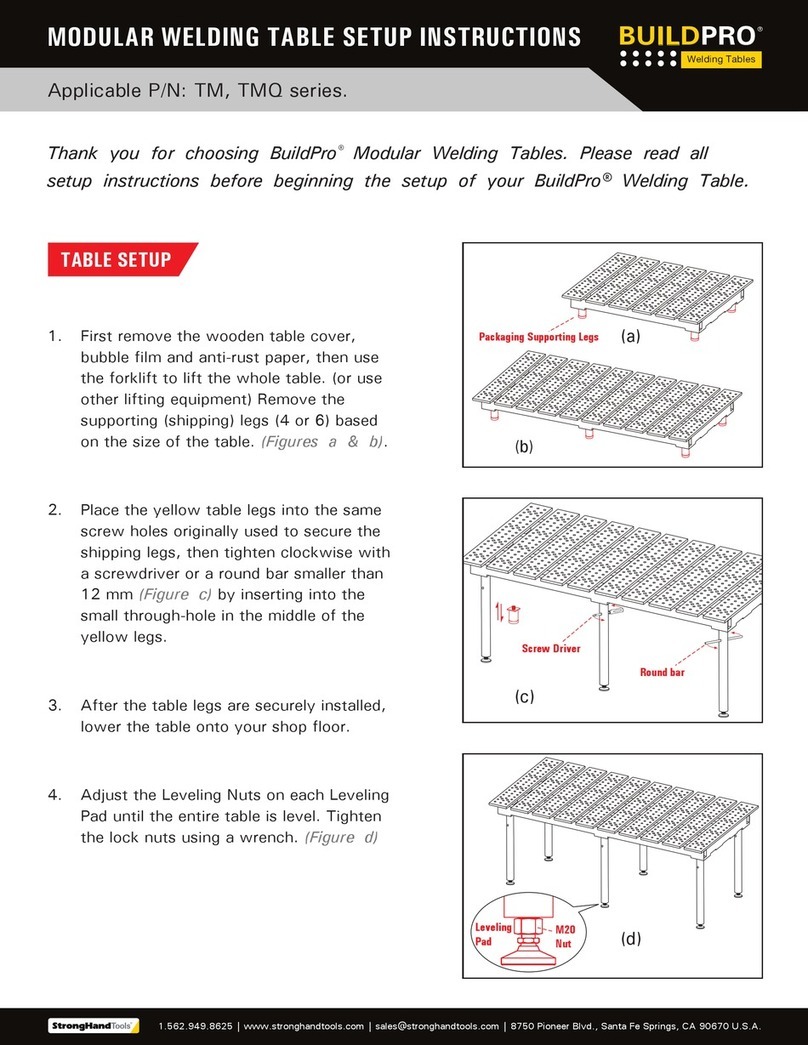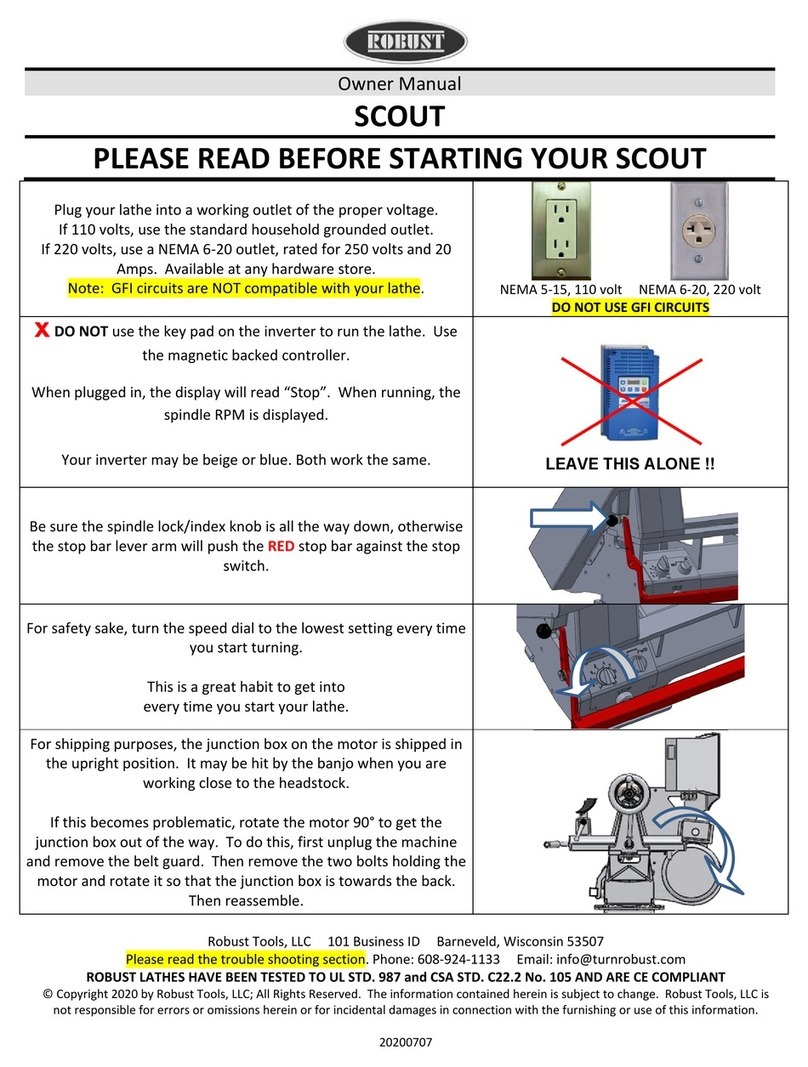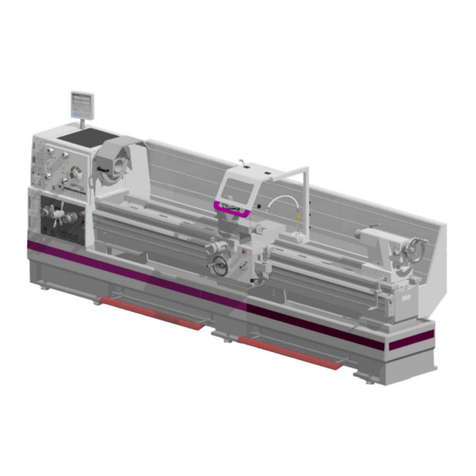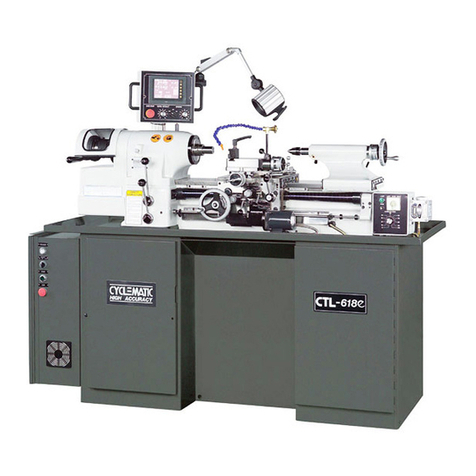MachineryHouse AL-346V User manual

INSTRUCTION MANUAL
AL-346V
Centre Lathe (240V)
330 x 1000mm Turning Capacity
L555D
Page 1
Instructions Manual for AL-346V (L555D)
01/09/2017

METAL LATHE
INSTRUCTION MANUAL
2015/11/V.1
Page 2
Instructions Manual for AL-346V (L555D)
01/09/2017

- 1 -
TABLE OF CONTENTS
TABLE OF CONTENTS 1 cutting fluid system 26
INTRODUCTION 2 Steady rest & follow rest 26
SECTION 1: SAFETY 4 Tool post 27
Safety instructions for machinery 4 Spindle speed 28
Additional safety for metal lathes 5 Manual feed 28
Additional chuck safety 6 Power feed 29
SECTION 2: POWER SUPPLY 7 Feed settings 29
Availability 7 Thread settings 30
Full-load current rating 7 SECTION 5:MAINTENANCE 32
Grounding instructions 7 Schedule 32
Extension cords 7 Cleaning 32
SECTION 3: SETUP 8 Ball oiler and change gears lubrication 32
Preparation 8 Oil reservoirs 33
Unpacking 8 V-belt tension 35
Cleanup 8 Cutting fluid system 35
Site considerations 9 SCETION 6: SERVICE 36
Lifting & moving 10 Troubleshooting 36
Mounting 10 Gib adjustments 38
Adding cutting fluid 11 Backlash adjustment 39
Check gearbox oil 11 Half nut adjustment 40
Power connection 11 Feed clutch adjustment 40
Installing V-Belts 12 Tailstock lock 41
Test run 12 Gap insert removal 41
SECTION 4:OPERATION 13 Machine storage 42
Operation overview 13 SECTION 7:PARTS LIST 43-80
Controls 14
Chuck & faceplate removal 17
Three-Jaw chuck 19
Four-Jaw chuck 20
Faceplate 22
Centers 23
Tailstock 24
Page 3
Instructions Manual for AL-346V (L555D)
01/09/2017

- 2 -
INTRODUCTION
Manual accuracy
We are proud to offer this manual with your new machine! We've made every effort to be exact with the instructions,
specifications, drawings, and photographs of the machine we used when writing this manual. However, sometimes
we still make an occasional mistake.
Also, owing to our policy of continuous improvement, your machine may not exactly match the manual. If you find
this to be the case, and the difference between the manual and machine leaves you in doubt, please contact us for
help.
Machine description
1. The purpose of a metal lathe is to face, turn, knurl, thread, bore, or cut tapers in a metal work piece with perfect
accuracy. 2. During typical operations, the lathe spindle rotates the work piece at various speeds against a fixed
cutting tool that is positioned at a particular angle for the desired type of cut. 3. The cutting tool is mounted on a tool
post, which is positioned by three different slides that each move in different directions. 4. Opposite of the headstock
and spindle is a support device called a tailstock. The tailstock can be slid along the lathe bed and locked in place to
firmly support the end of a work piece.
Identification
Brake Pedal
Feed
Selection
Lever
Spindle
ON/OFF
Lever
Thread
Dial
Fully Enclosed Fluid
Pump And Tank
Carriage
Handwheel
Compound Rest
Handwheel
Cutting Fluid
Nozzle
Lamp 3-Jaw
Chuck
Feed Speed
Dials
Haf-Nut
Lever
Control
Panel
Feed
Direction
Lever
Spindle
Speed
Lever
DRO
Display
Control
Panel
Cross
Slide
Handwheel
Tailstock
Page 4
Instructions Manual for AL-346V (L555D)
01/09/2017

- 3 -
Technical parameter
MAX. Swing over bed---------------------------------------------------------------------------------------------330mm (13 ")
MAX. Swing over cross slide---------------------------------------------------------------------------------------198mm (7.8")
MAX. Swing over gap--------------------------------------------------------------------------------------------17.71" (450mm)
MAX. Distance between centers-------------------------------------------------------------------------------1000mm (39.4")
Bed width------------------------------------------------------------------------------------------------------------181mm (7.08")
Spindle bore----------------------------------------------------------------------------------------------------------40mm (1.574")
Cam lock system------------------------------------------------------------------------------------------------------------------D4
Spindle taper---------------------------------------------------------------------------------------------------------------MT No.5
Spindle speed--------------------------------------------------------------------------------------------------70-2000rpm/2spets
Top Slide travel-----------------------------------------------------------------------------------------------------75mm (2.95" )
Cross slide travel---------------------------------------------------------------------------------------------------130mm (5.1" )
Carriage travel-----------------------------------------------------------------------------------------------------760mm (29.9" )
Cross-feed------------------------------------------------------------------------------------0.013-0.31mm (0.0005"-0.012")
Longitudinal feed------------------------------------------------------------------------------0.053-1.29mm (0.002"-0.051" )
Range of inch threads------------------------------------------------------------------------------------------4-60 TPI/36 steps
Range of metric threads----------------------------------------------------------------------------------------0.4-7mm/32 steps
Tailstock taper--------------------------------------------------------------------------------------------------------------MT No.3
Tailstock barrel travel-------------------------------------------------------------------------------------------------100mm (4" )
Cutting tool (Max. section) ------------------------------------------------------------------------- 14X14mm (0.55"x0.55" )
Weight (Net) ----------------------------------------------------------------------------------------------------600kg (1338 Lbs)
Weight (Shipping) ---------------------------------------------------------------------------------------------635kg (1416 Lbs)
Crate size (LXBXH) -------------------------------------------------------1870x740x1565mm (73.62 "X29.13"X61.62" )
Motor output----------------------------------------------------------------------------------------------------------1.5kw (2HP)
Page 5
Instructions Manual for AL-346V (L555D)
01/09/2017

- 4 -
SECTION 1: SAFETY
For your own safety, read instruction manual before operating this machine
DANGER! Indicates an imminently hazardous situation which, if not avoided, will result in death or serious injury.
WARNING! Indicates a potentially hazardous situation which, if not avoided, could result in death or serious injury.
CAUTION! Indicates a potentially hazardous situation which, if not avoided, may result in minor or moderate injury.
NOTICE! This symbol is used to alert the user to useful information about proper operation of the equipment, and/or
a situation that may cause damage to the machinery.
Safety instructions for machinery
WARNING!
1. Owner’s manual. Read and understand this owner’s manual before using machine.
2. trained operators only. Untrained operators have a higher risk of being hurt or killed. Only allow
trained/supervised people to use this machine. When machine is not being used, disconnect power, remove switch
keys, or lock-out machine to prevent unauthorized use—especially around children. Make workshop kid proof!
3. Dangerous environments. Do not use machinery in areas that are wet, cluttered, or have poor lighting. Operating
machinery in these areas greatly increases the risk of accidents and injury.
4. Mental alertness required. Full mental alertness is required for safe operation of machinery. Never operate under
the influence of drugs or alcohol, when tired, or when distracted.
5. Electrical equipment injury risks. You can be shocked, burned, or killed by touching live electrical components
or improperly grounded machinery. to reduce this risk, only allow qualified service personnel to do electrical
installation or repair work, and always disconnect power before accessing or exposing electrical equipment.
6. Disconnect power first. Always disconnect machine from power supply before making adjustments, changing
tooling, or servicing machine. This prevents an injury risk from unintended startup or contact with live electrical
components.
7. Eye protection. Always wear approved safety glasses or a face shield when operating or observing machinery to
reduce the risk of eye injury or blindness from flying particles. Everyday eyeglasses are not approved safety glasses.
8. Wearing proper apparel. Do not wear loose clothing or jewelry that can become entangled in moving parts.
Always tie back or cover long hair. Wear non-slip footwear to avoid accidental slips, which could cause loss of work
piece control.
9. Hazardous dust. Dust created while using machinery may cause cancer, long-term respiratory damage. Be aware
of dust birth defects, or hazards associated with each work piece material, and always wear an approved respirator to
reduce your risk.
10. Hearing protection. Always wear hearing protection when operating or observing loud machinery. Extended
exposure to this noise without hearing protection can cause permanent hearing loss.
11. Remove adjusting tools. Tools left on machinery can become dangerous projectiles upon startup. Never leave
chuck keys, wrenches, or any other tools on machine. Always verify removal before starting!
12. Use correct tool for the jib. Only use this tool for its intended purpose – do not force it or an attachment to do a
jib for which for it was not designed. Never make unapproved modifications-modifying tool or using it differently
than intended may result in malfunction or mechanical failure that can lead to personal injury or death!
13. Awkward positions. Keep proper footing and balance at all times when operating machine. Do not overreach!
Avoid awkward hand positions that make work piece control difficult or increase the risk of accidental injury.
14. Children & bystanders. Keep children and bystanders at a safe distance from the work area. Stop using machine
if they become a distraction.
Page 6
Instructions Manual for AL-346V (L555D)
01/09/2017

- 5 -
15. Guards & covers. Guards and covers reduce accidental contact with moving parts or flying debris. Make sure
they are properly installed, undamaged, and working correctly.
16. Forcing machinery. Do not force machine. It will do the job safer and better at the rate for which it was
designed.
17. Never stand on machine. Serious injury may occur if machine is tipped or if the cutting tool is unintentionally
contacted.
18. Stable machine. Unexpected movement during operation greatly increases risk of injury or loss of control.
Before starting, verify machine is stable and mobile base (if used) is locked.
19. Use recommended accessories. Consult this owner’s manual or the manufacturer for recommended accessories.
Using improper accessories will increase the risk of serious injury.
20. Unattended operation. To reduce the risk of accidental injury, turn machine OFF and ensure all moving parts
completely stop before walking away. Never leave machine running while unattended.
21. Maintain with care. Follow all maintenance instructions and lubrication schedules to keep machine in good
working condition. A machine that is improperly maintained could malfunction,
leading to serious personal injury or death.
22. Check damaged parts. Regularly inspect machine for any condition that may affect safe operation. Immediately
repair or replace damaged or mis-adjusted parts before operating machine.
23. Maintain power cords. When disconnecting cord-connected machines from power, grab and pull the plug—not
the cord. Pulling the cord may damage the wires inside. Do not handle cord/plug with wet hands. Avoid cord damage
by keeping it away from heated surfaces, high traffic areas, harsh chemicals, and wet/damp locations.
24. Experiencing difficulties. If at any time you experience difficulties performing the intended operation, stop using
the machine! Please contact technical support.
Additional safety for metal lathes
WARNING!
1. Speed rates. Operating the lathe at the wrong can cause nearby parts to break or the work piece to come loose,
which will result in dangerous projectiles that could cause severe impact injuries. Large or non-concentric work
pieces must be turned at slow speeds. Always use the appropriate feed and speed rates.
2. Chuck Key safety. A chuck key left in the chuck can become a deadly projectile when the spindle is started.
Always remove the chuck key after using it. Develop a habit of not taking your hand off of a chuck key unless it is
away from the chuck.
3. Safe clearances. Work pieces that crash into other components on the lathe may throw dangerous projectiles in all
directions, leading to impact injury and damaged equipment. Before starting the spindle, make sure the work piece
has adequate clearance by hand-rotating it through its entire range of motion. Also, check the tool and tool post
clearance, chuck clearance, and saddle clearance.
4. Long stock safety. Long stock can whip violently if not properly supported, causing serious impact injury and
damage to the lathe. reduce this risk by supporting any stock that extends from the chuck/headstock more than three
times its own diameter. Always turn long stock at slow speeds.
5. Securing Work piece. An improperly secured work piece can fly off the lathe spindle with deadly force; witch can
result in a severe impact injury. Make sure the work piece is properly secured in the chuck or faceplate before starting
the lathe.
6. Chucks. Chucks are heavy and difficult to grasp, witch can lead to crushed fingers or hands if mishandled. Get
assistance when handing chuck to reduce this risk. protect your hands and the precision-ground ways buy using a
chuck cradle or piece of plywood over the ways of the lathe when servicing chucks. Use lifting devices when
necessary.
7. Clearing chips. Metal chips can easily cut bare skin—even through a piece of cloth. Avoid clearing chips by hand
Page 7
Instructions Manual for AL-346V (L555D)
01/09/2017

- 6 -
or with a rag. Use a brush or vacuum to clear metal chips.
8. Stopping spindle by hand. Stopping the spindle by putting your hand on the work piece or chuck creates an
extreme risk of entanglement, impact, crushing, friction, or cutting hazards. Never attempt to slow or stop the lathe
spindle with your hand. Allow the spindle to come to a stop on its own or use the brake.
9. Crashes. Aggressively driving the cutting tool or other lathe components into the chuck may cause an explosion of
metal fragments, which can result in severe impact injuries and major damage to the lathe. Not leaving lathe
unattended, and checking clearances before starting the lathe. Make sure no part of the tool, tool holder, compound
rest, cross slide, or carriage will contact the chuck during operation.
10. Coolant safety. Coolant is a very poisonous biohazard that can cause personal injury from skin contact alone.
Incorrectly positioned coolant nozzles can splash on the operator or the floor, resulting in an exposure or slipping
hazard. To decrease your risk, change coolant regularly and position the nozzle where it will not splash or end up on
the floor.
11. Tool selection. Cutting with an incorrect or dull tool increases the risk of accidental injury due to the extra force
required for the operation, which increases the risk of breaking or dislodging components that can cause small shards
of metal to become dangerous projectiles. Always select the right cutter for the job and make sure it is sharp. A
correct, sharp tool decreases strain and provides a better finish.
Additional chuck safety
WARNING!
1. Entanglement. Entanglement with a rotating chuck can lead to death, amputation, broken bones, or other serious
injury. Never attempt to slow or stop the lathe chuck by hand, and always roll up long sleeves, tie back long hair, and
remove any jewelry or loose apparel before operating.
2. Chuck speed rating. Excessive spindle speeds greatly increase the risk of the work piece or chuck being thrown
from the machine with deadly force. Never use spindle speeds faster than the chuck RPM rating or the safe limits of
your work piece.
3. Using correct equipment. Many work pieces can only be safely turned in a lathe if additional support equipment,
such as a tailstock or steady/follow rest, is used. If the operation is too hazardous to be completed with the lathe or
existing equipment, the operator must have enough experience to know when to use a different machine or find a
safer way.
4. Trained operators only. Using a chuck incorrect can result in work pieces coming loose at high speeds and
striking the operator or bystanders with deadly force. To reduce the risk of this hazard, read and understand this
document and seek additional training from an experienced chuck user before using a chuck.
5. Chuck capacity. Avoid exceeding the capacity of the chuck by clamping an oversized work piece. If the work
piece is too large to safely clamp with the chuck, use a face plate or a large chuck if possible. Otherwise, the work
piece could be thrown from the lathe during operation, resulting in serious impact injury or death.
6. Clamping force. Inadequate clamping force can lead to the work piece being thrown from the chuck and striking
the operator or bystanders. Maximum clamping force is achieved when the chuck is properly maintained and
lubricated, all jaws are fully engaged with the work piece, and the maximum chuck clamping diameter is not
exceeded.
7. Proper maintenance. All chucks must be properly maintained and lubricated to achieve maximum clamping force
and withstand the rigors of centrifugal force. To reduce the risk of a thrown work piece, follow all maintenance
intervals and instructions in this document.
8. Disconnect power. Serious entanglement or impact injuries could occur if the lathe is started while you are
adjusting, servicing, or installing the chuck. Always disconnect the lathe from power before performing these
procedures.
Page 8
Instructions Manual for AL-346V (L555D)
01/09/2017

- 7 -
SECTION 2: POWER SUPPLY
Availability
Before installing the machine, consider the availability and
proximity of the required power supply circuit. If an
existing circuit does not meet the requirements for this
machine, a new circuit must be installed. To minimize the
risk of electrocution, fire, or equipment damage,
installation work and electrical wiring must be done by an
electrician or qualified service personnel in accordance
with all applicable codes and standards.
Full-load current rating
The full-load current rating is the amperage a machine draws at 100% of the rated output power. On machines with
multiple motors, this is the amperage drawn by the largest motor or sum of all motors and electrical devices that
might operate at one time during normal operations.
The full-load current is not the maximum amount of amps that the machine will draw. If the machine is overloaded, it
will draw additional amps beyond the full-load rating.
If the machine is overloaded for a sufficient length of time, damage, overheating, or fire may result—especially if
connected to an undersized circuit. To reduce the risk of these hazards, avoid overloading the machine during
operation and make sure it is connected to a power supply circuit that meets the requirements of the machines.
A power supply circuit includes all electrical equipment between the breaker box or fuse panel in the building and the
machine. The power supply circuit used for this machine must be sized to safely handle the full-load current drawn
from the machine for an extended period of time.
CAUTION! For your own safety and protection of property, consult an electrician if you are unsure about wiring
practices or electrical codes in your area.
Grounding instructions
This machine MUST be grounded. In the event of certain malfunctions or breakdowns, grounding reduces the risk of
electric shock by providing a path of least resistance for electric current.
WARNING! Serious injury could occur if you connect the machine to power before completing the setup process.
DO NOT connect to power until instructed later in this manual.
Improper connection of the equipment-grounding wire can result in a risk of electric shock. The wire with green
insulation and yellow stripes is the equipment-grounding wire. If repair or replacement of the power cord or plug is
necessary, do not connect the equipment-grounding wire to a live (current carrying) terminal.
Check with a qualified electrician or service personnel if you do not understand these grounding requirements, or if
you are in doubt about whether the tool is properly grounded. If you ever notice that a cord or plug is damaged or
worn, disconnect it from power, and immediately replace it with a new one.
Extension cords
We do not recommend using an extension cord with this machine. If you must use an extension cord, only use it if
absolutely necessary and only on a temporary basis.
Extension cords cause voltage drop, which may damage electrical components and shorten motor life. Voltage drop
increases as the extension cord size gets longer and the gauge size gets smaller (higher gauge numbers indicate
smaller sizes). Any extension cord used with this machine must contain a ground wire, match the required plug and
receptacle, and wire as short as possible.
Page 9
Instructions Manual for AL-346V (L555D)
01/09/2017

- 8 -
SECTION 3:SETUP
Preparation
The list below outlines the basic process of preparing your machine for operation. Specific steps are covered later in
this section. The typical preparation process is as follows:
1. Unpack the lathe and inventory the contents of the box/crate.
2. Clean the lathe and its components.
3. Ldentify an acceptable location for the lathe and move it to that location.
4. Level the lathe and bolt it to the floor.
5. Assemble the loose components and make any necessary adjustments or inspections to ensure the lathe is ready for
operation.
6. Check lathe for proper lubrication.
7. Connect the lathe to the power source.
8. Test run lathe to ensure it functions properly.
9. Perform the spindle break-in procedure to prepare the lathe for operation.
Unpacking
Your machine was carefully packaged for safe transportation. Remove the packing materials from around your
machine and inspect it. If you discover the machine is damage, please contact us.
Cleanup
The unpainted surfaces of your machine are coated with a heavy-duty rust preventative that prevents corrosion during
shipment and storage. This rust preventative works extremely well, but it will take a little time to clean.
Be patient and do a thorough job cleaning your machine. The time you spend doing this now will give you a better
appreciation for the proper care of your machine's unpainted surfaces.
There are many ways to remove this rust preventative,
but the following steps work well in a wide variety of
situations. Always follow the manufacturer’s instructions
with any cleaning product you use and make sure you
work in a well-ventilated area to minimize exposure to
toxic fumes.
Before cleaning, gather the following:
• Disposable Rags
• Cleaner/degreaser
• Safety glasses & disposable gloves
• Plastic paint scraper (optional)
Basic steps for removing rust preventative:
1. Put on safety glasses.
2. Coat the rust preventative with a liberal amount of
Page 10
Instructions Manual for AL-346V (L555D)
01/09/2017

- 9 -
cleaner/degreaser, then let it soak for 5–10 minutes.
3. Wipe off the surfaces. If your cleaner/degreaser is
effective, the rust preventative will wipe off easily. If you
have a plastic paint scraper, scrape off as much as you
can first, then wipe off the rest with the rag.
4. Repeat Steps 2–3 as necessary until clean, then coat all
unpainted surfaces with a quality metal protectant to
prevent rust.
Additional cleaning tips
• For thorough cleaning, remove the steady rest, tool post, compound slide, and changegears.
• use a stiff brush when cleaning the threads on the leadscrew.
• Move the slides and tailstock back and forth to thoroughly clean/lubricate underneath them.
• After cleaning, wipe down the ways with a high-quality way oil.
Site considerations
Weight Load
Refer to the Machine Data Sheet for the weight of your machine. Make sure that the surface upon which the machine
is placed will bear the weight of the machine, additional equipment that may be installed on the machine, and the
heaviest work piece that will be used. Additionally, consider the weight of the operator and any dynamic loading that
may occur when operating the machine.
Space Allocation
Consider the largest size of work piece that will be processed through this machine and provide enough space around
the machine for adequate operator material handling or the
installation of auxiliary equipment. With permanent
installations, leave enough space around the machine to
open or remove doors/covers as required by the
maintenance and service described in this manual.
See below for required space allocation.
Physical Environment
The physical environment where the machine is operated is important for safe operation and longevity of machine
components. For best results, operate this machine in a dry environment that is free from excessive moisture,
hazardous chemicals, airborne abrasives, or extreme conditions. Extreme conditions for this type of machinery are
Page 11
Instructions Manual for AL-346V (L555D)
01/09/2017

- 10 -
generally those where the ambient temperature range exceeds 41°–104°F(0°–40°C); The relative humidity range
exceeds 20–95% (non-condensing); or the environment is subject to vibration, shocks, or bumps.
Electrical Installation
Place this machine near an existing power source. Make sure all power cords are protected from traffic, material
handling, moisture, chemicals, or other hazards. Make sure to leave access to a means of disconnecting the power
source or engaging a lockout/tagout device, if required.
Lighting
Lighting around the machine must be adequate enough that operations can be performed safely. Shadows, glare, or
strobe effects that may distract or impede the operator must be eliminated.
Lifting & moving
WARNING! You must use power lifting equipment and
assistance to lift and move this machine. Inspect all lifting
equipment to make sure it is in working order and rated for the
load before attempting to lift. Ignoring this warning may lead to
serious personal injury or death.
This lathe has a hole built into each end of the stand (see figure)
that is designed to accept a sturdy 25mm (1”) diameter lifting
bar. each bar must extend far enough from the stand so that
chains or lifting straps can be looped or connected to all four
corners and the lathe can be lifted.
Mounting
Although not required, we recommend that you mount your new machine to the floor. Because this is an optional step
and floor materials may vary, floor mounting hardware is not included. Generally, you can either bolt your machine to
the floor or mount it on machine mounts. Both options are described below. Whichever option you choose, it is
necessary to level your machine with a precision level.
Bolting to concrete floors
Lag shield anchors with lag screw and anchor studs (see figure) are two popular methods for anchoring an object to a
concrete floor. We suggest you research the many options and methods for mounting your machine and choose the
best that fits your specific application.
Lifting Holes
Page 12
Instructions Manual for AL-346V (L555D)
01/09/2017

- 11 -
Using machine mounts
Using machine mounts, shown in Figure, gives the advantage of fast leveling and vibration reduction. The large size
of the foot pads distributes the weight of the machine to reduce strain on the floor.
Using foundation bolts
Place the lathe on a solid foundation. A concrete floor is the best base for the machine. (If necessary, use
an under frame operational). Make sure there is sufficient area around the lathe for easy work and
maintenance. Use a precision level on the bedways to make further adjustment for level condition, tighten
the foundation bolts evenly and finally recheck for level condition.
NOTICE! For accurate turning results
and to prevent warping the cast iron bed
and ways, the lathe bedways must be
leveled from side-to side and from
front-to back on both ends. Re-check
the bedways 24 hours after installation,
two weeks after that, and then annually
to make sure they remain level.
C
Check gearbox oil
It is critical that there is oil in the headstock, quick change gearbox, and the apron gearbox before proceeding with the
test run. Refer to the lubrication instructions on page 32 for more details on which type and how much oil to use in
each gearbox.
Adding cutting fluid
For detailed instructions on where the cutting fluid tank is located and how to add fluid, refer to cutting fluid system
on page 35.
Power connection
Once all preparation steps previously described in this manual have been completed, the machine can be connected to
the power source. In order to be connected to the power source, a circuit must be installed/prepared that meets the
requirements of the lathe, and a power connection method must be established for that circuit.
Using an incorrectly sized cord causes machine electrical
components and the cord to become very hot, which can lead
to component failure or result in fire. For best results, use the
shortest length of cord possible, and never use a smaller cord
gauge than the specified minimum.
Page 13
Instructions Manual for AL-346V (L555D)
01/09/2017

- 12 -
Installing V-Belts
1. Open end gear cover to expose pulleys.
2. Clean surfaces of pulleys, making sure to remove and
oily residue from pulley sheaves
3. Install and tension V-belts (refer to
Tensioning/Replacing V-Belts on Page 35 in Owner’s
Manual for detailed instructions)
4. Wipe face of pulleys with light layer of way oil to
prevent rust. Take care to avoid leaving any excess oil
that could get flung off or contact belts.
Test run
Once assembly is complete, test run the machine to make sure it runs properly and is ready for regular operation. The
test run consists of verifying the following: the motor powers up and runs correctly and the stop button safety feature
works correctly.
If, during the test run, you cannot easily locate the source of an unusual noise or vibration, stop using the machine
immediately, then review troubleshooting on page 36. If you cannot find a remedy, contact our tech support for
assistance.
To begin the test run:
1. Make sure you understand the safety instructions at the beginning of the manual and that all previous setup
sections have been completed.
2. Make sure the lathe is lubricated and the oil levels are at the full mark. Refer to maintenance on page 32 for details.
3. Make sure the chuck is correctly secured to the spindle. Refer to chuck and faceplate mounting on page for detailed
installation instructions.
4. Make sure all tools and objects used during setup are cleared away from the machine.
NOTICE! Never shift lathe gears when lathe is operating, and make sure both the half nut lever and the feed
selection lever are disengaged before you start the lathe! Otherwise the carriage may feed into the chuck or tailstock
and cause severe damage.
5. Disengage the half-nut lever and the feed selection
lever (see Figure 1), and make sure the saddle lock is
loosened to allow the lead screw or feed rod to move the
apron if required.
6. Make sure the cutting fluid pump switch is OFF; point
the cutting fluid nozzle into the lathe chip pan.
WARNING! Before starting the lathe, make sure you
have performed any preceding assembly and adjustment
instructions, and you have read through the rest of the
manual and are familiar with the various functions and
safety features on this machine. Failure to follow this
warning could result in serious personal injury or even
death!
7. Rotate the stop button (see Figure 2) clockwise until it pops out.. Figure 1
Page 14
Instructions Manual for AL-346V (L555D)
01/09/2017

- 13 -
8. Move the feed direction lever (see Figure 2) to the disengaged middle position.
9. Turn the spindle speed control knob (Figure 2) all the way counterclockwise (lowest speed) to avoid possibility of
a high-speed start.
10. Move the spindle speed range lever (Figure 2) to the “L” position so the headstock is set in the low range
(70-440RPM). You may need to slightly rotate the chuck by hand to engage the lever.
11. Connect the lathe to power source, and then turn the main power switch to the ON position (Figure 3)
12. Move the spindle ON/OFF lever to start the lathe. The spindle will rotate at 70 rpm. When operating correctly, the
machine runs smoothly with little or no vibration or rubbing noises.
— investigate and correct strange or unusual noises or vibrations before operating the machine further. Always
disconnect the machine from power when investigating or correcting potential problems.
13. Move the spindle ON/OFF lever to the center position,
and press the stop button.
14. Without resetting the stop button, move the spindle
ON/OFF lever down. The machine should not start.
—if the machine does not start, the stop button safety
feature is working correctly. Continue to the next step.
—if the machine starts (with the stop button pushed in),
immediately disconnect power to the machine. The stop
button safety feature is not working correctly. This safety
feature must work properly before proceeding with
regular operations. Call tech support for help.
15. Rotate the stop button clockwise until it pops out.
16. Make sure the lamp works.
Figure 2
17. Make sure that the cutting fluid nozzle is pointing toward the chip pan, then turn the cutting fluid pump switch
and open the nozzle valve. After verifying that cutting fluid flows from the nozzle, turn the cutting fluid switch OFF.
18. Start the spindle, and then step on the brake pedal. The power to the motor should be cut and the spindle should
come to an immediate stop.
SECTION 4:OPERATION
Operation overview
This overview is the basic process that occurs when operating this machine. Familiarize yourself with these steps to
better understand the remaining parts of the operation section.
To complete a typical operation, the operator does the following:
1. Puts on safety glasses, rolls up sleeves, removes jewelry, and secures any clothing, jewelry, or hair that could get
entangled in moving parts.
Page 15
Instructions Manual for AL-346V (L555D)
01/09/2017

- 14 -
2. Examines the work piece to make sure it is suitable for turning, and then mounts the work piece required for the
operation.
3. Mounts the tooling, aligns it with the work piece, and
then adjusts it for a safe startup clearance.
4. Clears all tools from the lathe.
5. Sets the correct spindle speed for the operation.
6. Checks for safe clearances by rotating the work piece
by hand one full revolution.
7. Moves slides to where they will be used during
operation. If using power feed, selects the proper feed
rate for the operation.
8. Turns the main power switch ON, resets the stop
button so it pops out, then moves the spindle ON/OFF
lever to start spindle rotation. The spindle will rotate
forward (the top of the chuck rotates toward the
operator).
9. Uses the carriage handwheels or power feed options
to move the tooling into the work piece for operations.
10. When finished cutting, moves the ON/OFF lever to
the center position to turn the lathe OFF then removes the
work piece.
Controls
Main Power Switch
The main power switch is shown in Figure 3.
It turns master power ON/OFF to the lathe.
Headstock controls
Use the descriptions in this section and the controls
shown in Figure 2 to quickly understand the functions
of the headstock and quick change gearbox controls,
and to find their locations on the lathe.
01. Spindle Speed Range Levers: Shifts the headstock
into low or high range for spindle speeds between
70-440 RPM or 350-2000 RPM.
Figure 3
02. Feed Direction Lever: Controls the forward and reverse direction of the carriage and cross feed. When this lever
moved left or right, the direction of the quick change gearbox, feed rod, and lead screw reverse direction, but spindle
direction is unaffected.
03.Power Light: When the lathe is connected to power, it is not necessarily ready for use. Only when the stop button
is twisted clockwise and popped-out, and the on button has been pushed will the power light illuminate and indicate
that all electrical controls are "live" and ready for use. Just because the power light is OFF, do not assume that the
Page 16
Instructions Manual for AL-346V (L555D)
01/09/2017

- 15 -
lathe is safe for electrical work, general adjustments, or work piece changes. You must always disconnect the lathe
from power before attempting any of these tasks.
04. Cutting fluid ON/OFF Switch: Toggles the cutting fluid pump ON or OFF. Never turn the cutting fluid pump on
and let it run while the reservoir is empty, or pump damage may occur.
05. Feed Speed Dials: Engage either the feed rod or leadscrew, and set the apron speed for threading, turning, or
facing operations.
06. Emergency Stop Button: Cuts power to the spindle motor and the control panel. No braking occurs and the
spindle, chuck, and work piece wind-down naturally. After being pressed, the stop button stays pushed in until it is
reset by twisting the knob clockwise until it pops back out.
07. Jog Button: Bumps the motor ON and OFF so partial spindle rotation occurs in reverse. Useful when the lathe is
stopped in low range and the lathe gear reduction makes it difficult for the machinist to rotate the chuck by hand in
order to reposition a chuck or work piece. Note: In order to use the jog button, the Spindle ON/OFF lever must be in
the central or OFF position.
08. Speed Display: Displays the current spindle speed in RPM.
09. Speed Control Knob: Changes the spindle speed within the set speed range.
10. Reset Button: Motor will stop when the load exceeds the motor rated power and the red light of the Reset Button
will be lighted. If you want to restart the lathe, first move the Spindle ON/OFF Lever to the STOP position, then push
the Reset Button and the red lights will be gone out. Now you can restart the lathe.
Apron controls
Use the descriptions in this section and the controls
shown in Figure 4 to quickly understand the functions of
the apron and its related controls.
Spindle ON/OFF Lever
Starts and stops the spindle in forward and reverse.
• Moving the lever upward from the central OFF position
spins the chuck forward (the top of the chuck moves
toward the machinist).
• Moving the lever downward from the central position
spins the chuck in reverse (the top of the chuck moves
away from the machinist).
Figure 4
Feed Selection Lever:Allows the machinist to engage or
disengage the apron for longitudinal or cross feeding tasks.
Carriage Lock Lever:Clamps the right front of the saddle
to the lathe way for increased rigidity when facing a
workpiece.
Half-Nut Lever:Clamps the halfnut to the leadscrew for
threading operations.
Thread Dial:Avoids cross-cutting threads by indicating to
the machinist where to re-clamp the half nut in order to
resume threading after a carriage return. (Figure 5)
Carriage Handwheel
For moves the carriage longitudinally left or right along the
ways. (Figure 5)
Figure 5
Page 17
Instructions Manual for AL-346V (L555D)
01/09/2017

- 16 -
Cross Slide Handwheel
Moves the cross slide in or out perpendicular to carriage travel and is equipped with a standard Dial. (Figure 5)
Compound Slide Handwheel(Figure 5)
Moves the compound and cutting tool relative to the workpiece at various angles with fine-depth control.
Compound Slide Scale(Figure 5)
The 90° rosette on the top of the compound indicates compound angles. Zero splits the scale into two ranges, 45° to
the right and 45° to the left in 1° degree increments.
Tailstock
Use the descriptions in this section and the controls shown in Figure 6 to quickly understand the functions of the
tailstock controls.
Quill Lock Lever
Secures the quill in a locked or pre-loaded position.
Tailstock Lock Lever
Clamps the tailstock in place for general position
locking along the lathe bed.
Set screw
Allows the tailstock to be locked in place using a
wrench to control amount of drawdown alignment with
the spindle centerline.
Tailstock Handwheel
Advances or retracts the quill in the tailstock at a 1:1
ratio with the micrometer scale on the handwheel hub. Figure 6
Micrometer Scale
Brake
This lathe is equipped with a foot brake (see Figure7)
to quickly stop the spindle. Pushing the foot brake
while the spindle is ON cuts power to the motor and
stops the spindle. Once stopped, the spindle ON/OFF
lever MUST be returned to the neutral position before
the spindle can be restarted.
WARNING!
Using the foot brake to stop the lathe reduces risk of an
entanglement injury from allowing the lathe to coast to
a stop. Use the foot brake to stop the lathe whenever
possible.
Figure 7
Spindle ON/OFF Lever
Foot Brake
Page 18
Instructions Manual for AL-346V (L555D)
01/09/2017

- 17 -
Chuck & faceplate removal/installation
This lathe is shipped with a 3-jaw chuck installed, but some time you need to use a 4-jaw chuck or faceplate. The
chucks and faceplate mount to the spindle with a camlock system, which uses a key to loosen and tighten camlocks
for removal or installation (see Figure 8).
Figure 8 Figure 9
Before the 4-jaw chuck and faceplate can be installed on the spindle, their respective cam studs must be installed and
adjusted. To maintain consistent removal and installation of the chucks and faceplate, each should have a timing mark
that can be lined up with a matching one on the spindle, so it will be installed in the same position every time (see
Figure 9). Before removing the 3-jaw chuck, verify that a timing mark exists. If a mark cannot be found, stamp your
own on both the chuck and spindle.
Chuck & faceplate removal
1. Disconnect lathe from power!
2. Lay a chuck cradle (see Figure 10) or a layer of plywood
over the bed ways to protect the precision ground surfaces
from damage and to prevent fingers from being pinched.
Figure 10
3. Loosen the cam-locks by turning the key counterclockwise
approximately one-third of a turn until the mark on the
cam-lock aligns with the single mark on the spindle nose in
Figure 11. If the cam-lock stud does not freely release from the
cam-lock, wiggle the cam-lock until the cam-lock stud releases.
Note: These cam-locks may be very tight. A breaker bar may be
used to add leverage.
4. Using a dead blow hammer or other soft mallet, lightly tap
around the outer circumference of the chuck body to break the
chuck free from the cam-locks and from the spindle nose taper.
Caution: the chuck may come off at this point, so it is important you are ready to support its weight.
Page 19
Instructions Manual for AL-346V (L555D)
01/09/2017

- 18 -
WARNING! Large chucks are very heavy. Always get
assistance when removing or installing large chucks to prevent
personal injury or damage to the chuck or lathe.
5. Use a rocking motion to carefully remove the chuck from
the spindle (see Figure 12).
—if the chuck does not immediately come off, rotate the spindle
approximately 60˚ and tap again. Make sure all the marks on the
cams and spindle are in proper alignment.
Figure 11
Chuck & faceplate installation
1. Disconnect lathe Form power!
2. Place a piece of plywood across the lathe ways just under the
chuck, and use a chuck cradle if desired.
3. Make sure the chuck taper and spindle taper mating surfaces
are perfectly clean.
4. Inspect and make sure that all camlock studs are undamaged,
are clean and lightly oiled, and that the camlock stud cap screws
are in place and snug.
Figure 12
NOTICE!Never install a chuck or faceplate without having the camlock cap screws in place or fully tightened. If
you ignore this notice, once installed the chuck may never be able to be removed since the camlock
studs will turn with the camlocks and never release.
5. Align the chuck-to-spindle timing marks , and slide the
chuck onto the spindle.
6. Turn a camlock with the chuck wrench until the cam mark
falls between the "v" marks as shown in Figure 13.
— If the cam lock mark stops outside of the “v” marks,
remove the chuck and adjust the cam stud height of the
offending studs one full turn up or down (see Figure 13).
Figure 13
7. Lock the other cams in a star pattern so the chuck is drawn up evenly on all sides without any chance of
misalignment.
Note: If any of the cam lock marks (see Figure 14) do not fall between the "V" marks when the cam lock is tight,
you must adjust the offending camlock stud as discussed in Camlock Stud Installation.
8. Remove the chuck wrench.
Camlock stud installation
1. Oil and thread each cam stud into the chuck until the alignment groove is flush with the chuck surface as shown in
Figure 14. 2. Install and tighten the locking cap screw for each stud, making sure that the camlock studs can
slightly rotate back and forth. 3. Place the chuck onto the spindle and tighten the cam locks in an alternating manner
to avoid cocking the chuck on the spindle. When tightened:
— If the cam lock mark stops outside of the "v" marks, remove the chuck and adjust the cam stud height of the
offending studs one full turn (see Figure 14).
— If the final position of each cam mark is between the two "v" marks as shown in Figure 14, no stud adjustment is
required.
Page 20
Instructions Manual for AL-346V (L555D)
01/09/2017
Table of contents
Other MachineryHouse Lathe manuals
Popular Lathe manuals by other brands
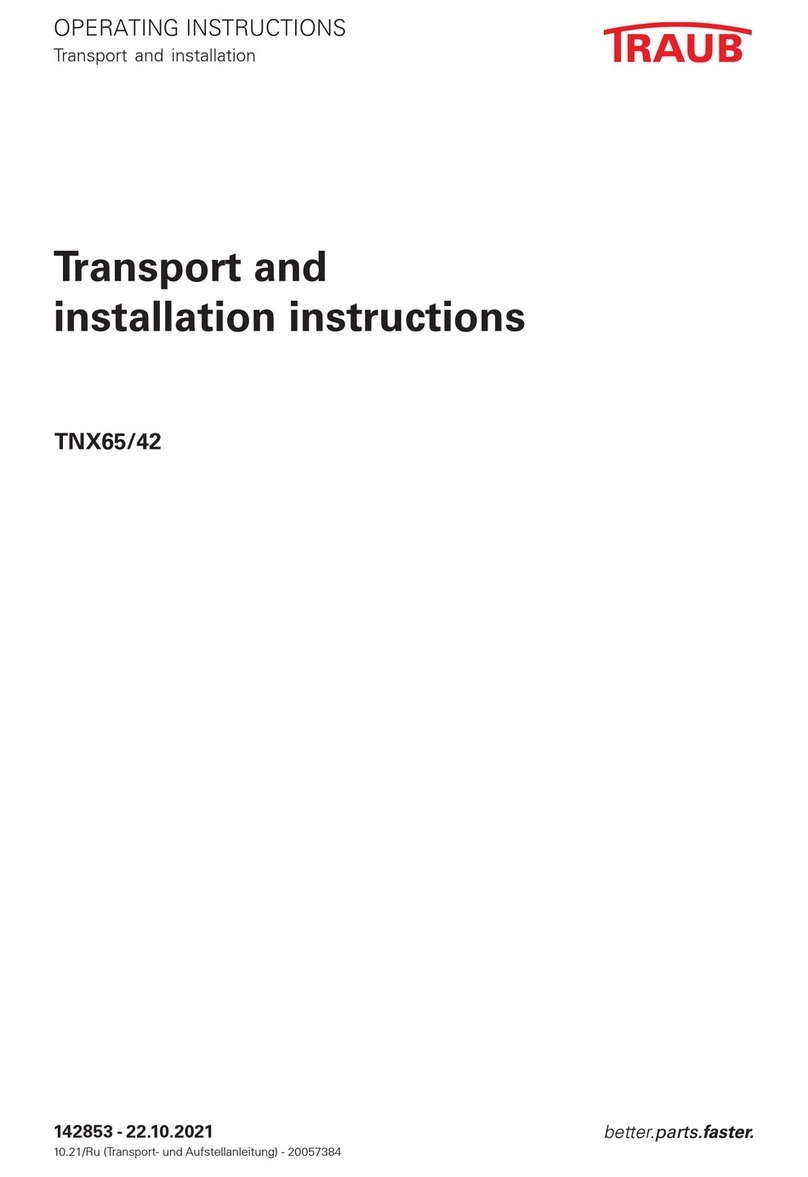
Traub
Traub TNX65 operating instructions
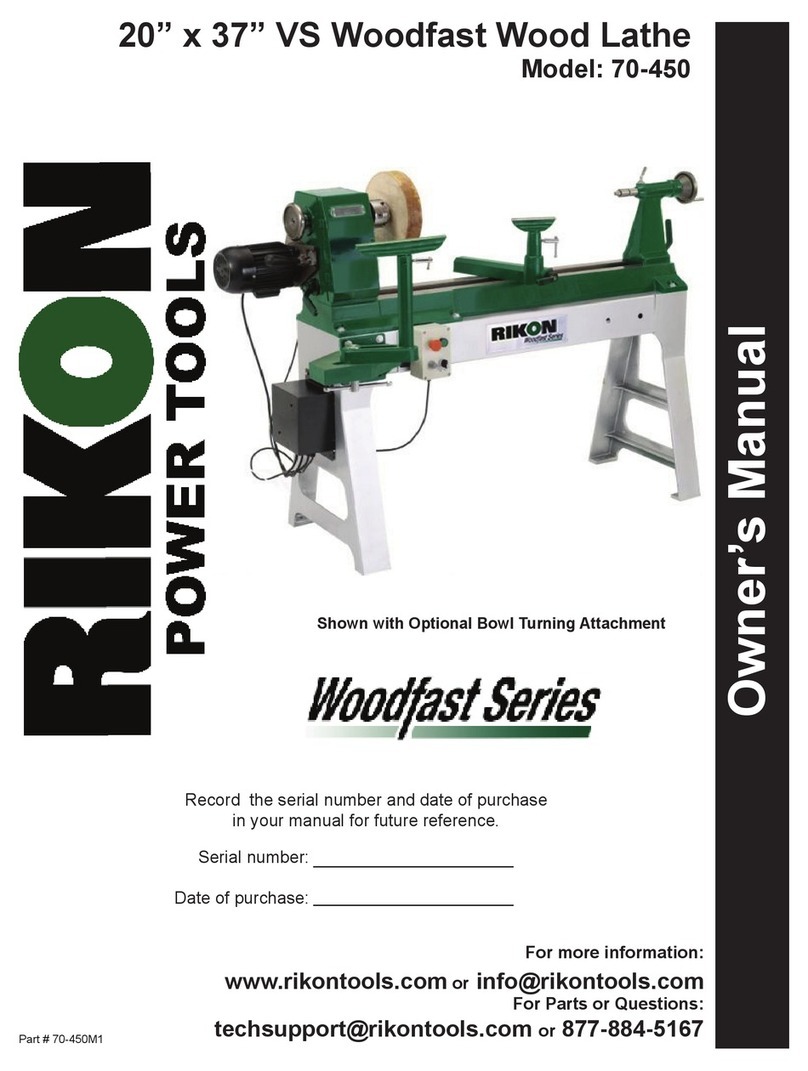
Rikon Power Tools
Rikon Power Tools Woodfast 70-450 owner's manual
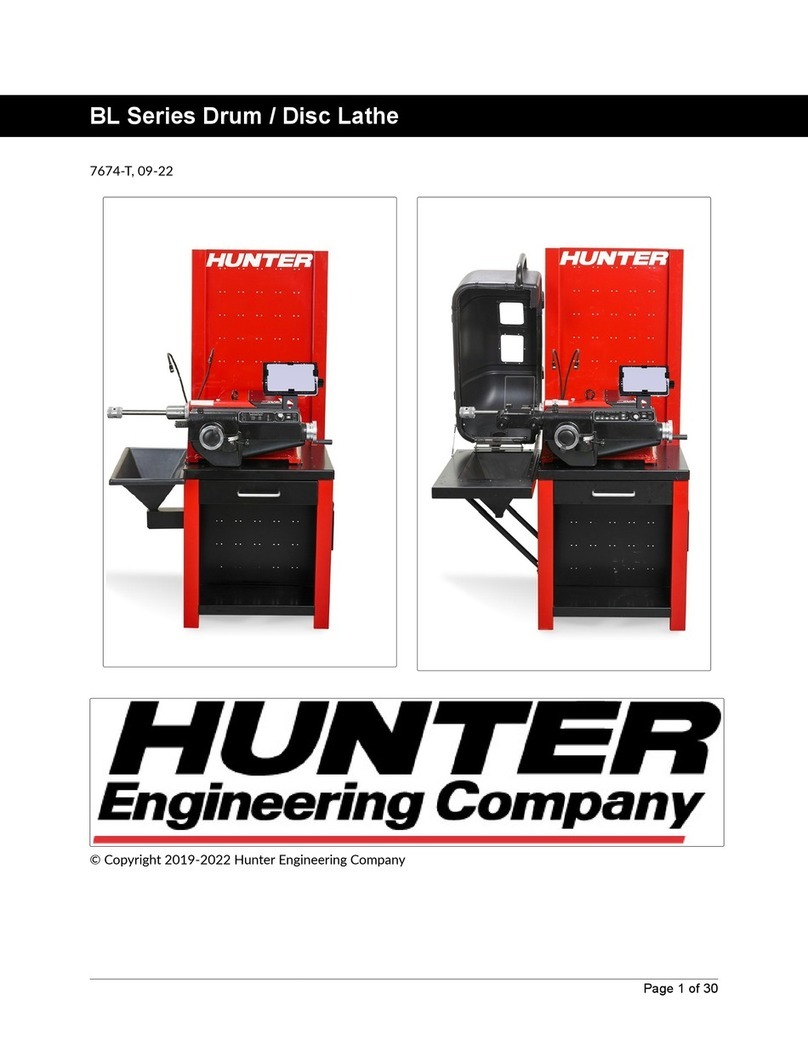
Hunter
Hunter BL Series manual
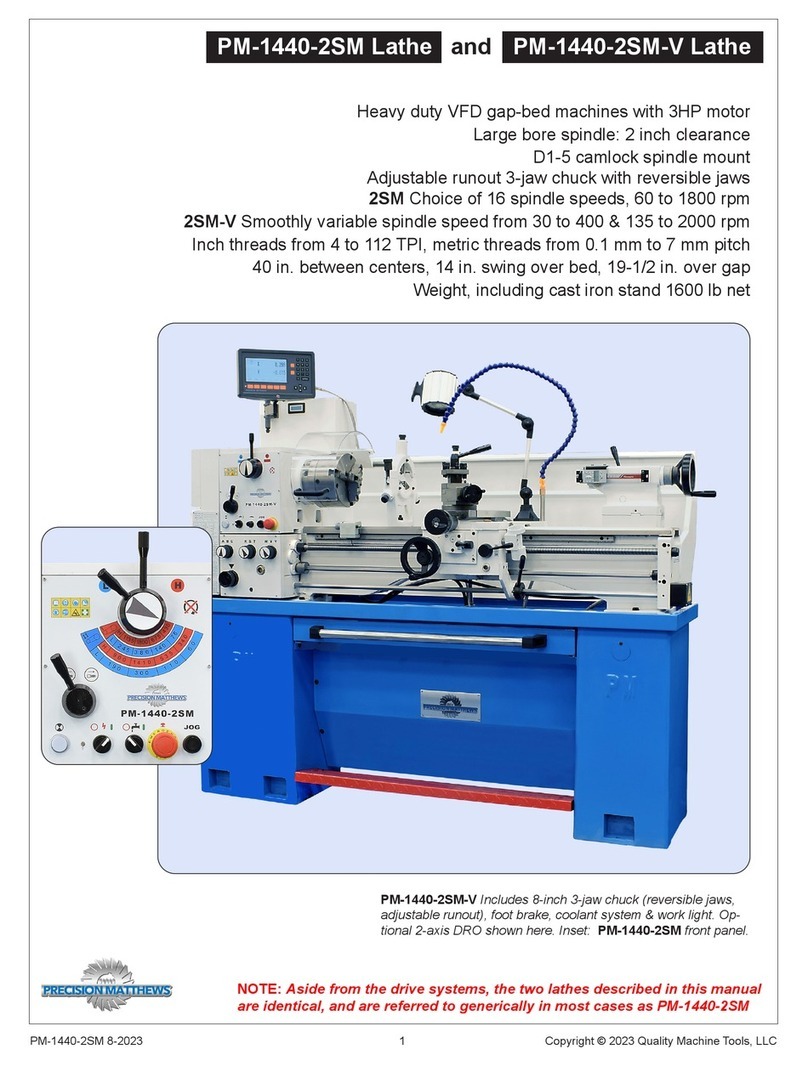
Precision matthews
Precision matthews PM-1440-2SM manual
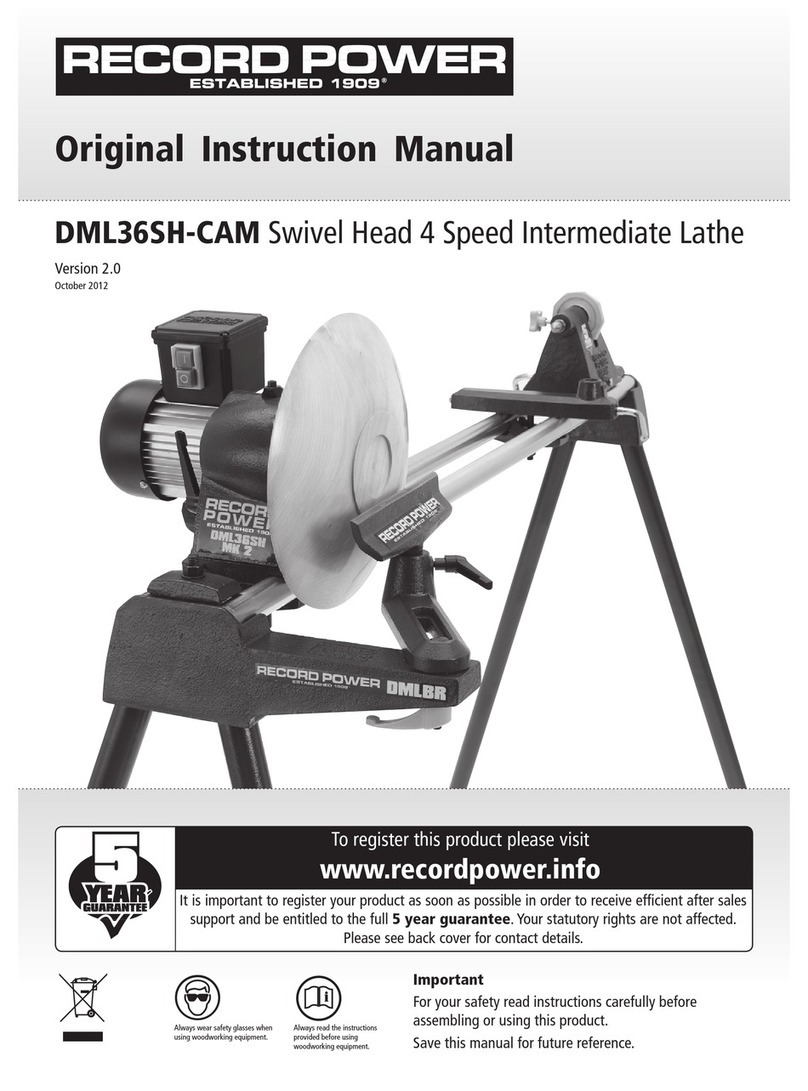
Record Power
Record Power DML36SH-CAM Original instruction manual
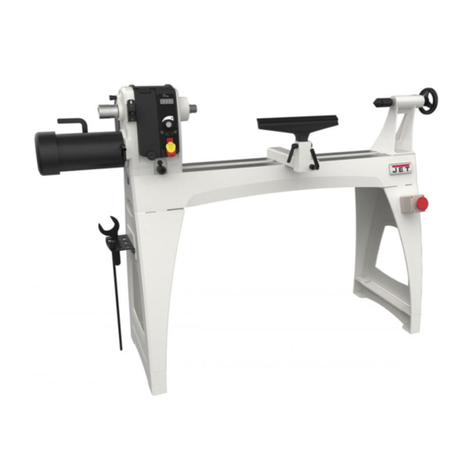
Jet
Jet JWL-1840DVR Operating instructions and parts manual





